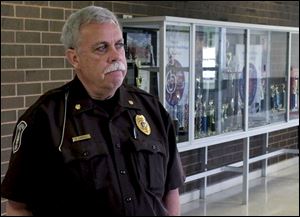
School safety shouldn't be a tough sell
8/18/2018
Sylvania Police Chief Ray Carroll attends the Sylvania Schools Safety and Security Committee forum, which hosted survivors from the West Salem-Liberty school shooting.
Students are headed back to class for a new school year and in the Parkland, Fla., high school where 17 were gunned down in February and they are finding millions of dollars worth of new security upgrades.
Marjory Stoneman Douglas High School spent $6.5 million over summer break to install 18 safety monitors, new classroom locks, and upgraded video surveillance.
Click here to view more Blade editorials
Those are the types of security measures Sylvania Schools would like to invest in before a shooting happens on one of their campuses. The district will ask voters in November for a 0.9-mill levy to pay for them.
The increased revenue would be used for about $3 million in security measures, including internal and external digital cameras at every school, an additional school resource officer at each of the three junior high schools, eight new mental health counselors, an upgraded electronic visitation/check-in process, and an upgraded phone system to make communication with police easier in an emergency.
Sylvania’s proposed security upgrades are a direct reaction to the Parkland shooting. The plan was drafted by a district safety and security team, which met for months after the Florida school massacre and a bomb threat at Sylvania schools that followed shortly after it.
Some have balked at the proposal. Why should local taxpayers have to vote themselves yet another property tax just to get schools that are better secured against gunmen?
It is a reasonable question. And it is also reasonable to question how less wealthy districts — large urban districts with dense poverty or tiny rural districts with a much smaller tax base — could afford to make their schools safe.
In Florida, the state legislature responded to the Parkland shooting with a new law that requires public schools to post armed guards. Those guards are on campus at Marjory Stoneman Douglas High School, though other districts are struggling to find the money to pay for them. The state also created a new Office of Safe Schools, which has at least offered some resources for local districts, including an app that would enable users to anonymously report suspicious activity in schools.
State funding Ohio’s public schools has not kept pace with the everyday demands of staffing, supplies, facilities that districts have always had to provide. After being adjusted for inflation, Ohio’s local K-12 funding has increased on average, just over 1 percent each year for the last 20 years. That certainly does not offer enough to help schools pay for millions in security upgrades.
That must change.
Ohio’s next governor and its General Assembly must see safe and secure schools for the necessity that they are. Florida’s model of a statewide safe schools office is a good one, but Ohio must take it a step further and fund programs that help schools with the money they need to secure buildings and provide better mental health resources.
Sylvania voters will have to decide if they want to approve a levy that brings those security measures to their own schools this fall, but Ohio’s leaders should understand it is their responsibility to make sure children across the state can at least feel reasonably safe in class.